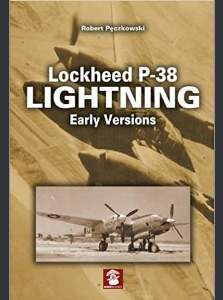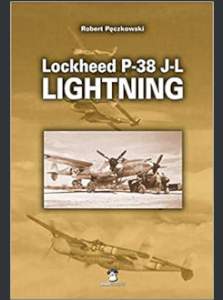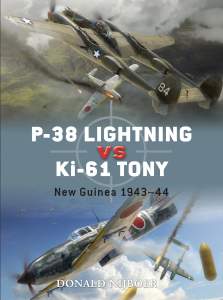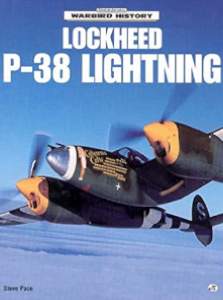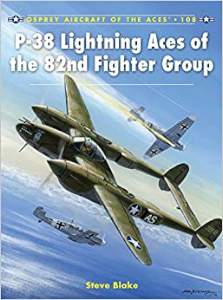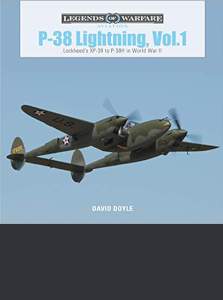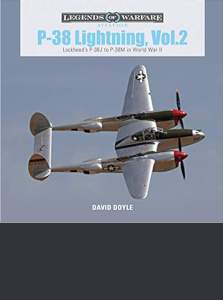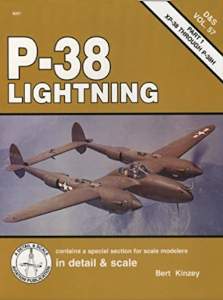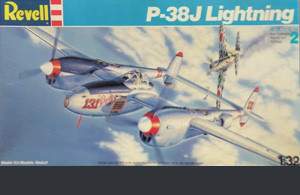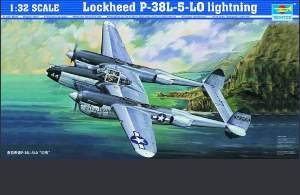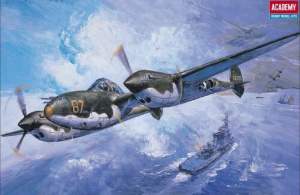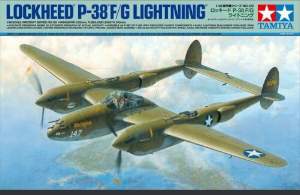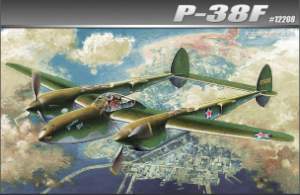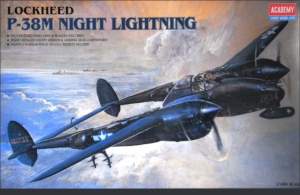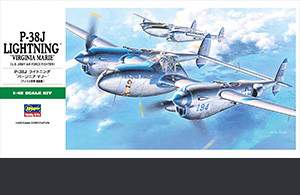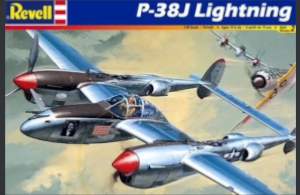Home » Military Aircraft » World War 2 Aircraft » Lockheed P-38 Lightning
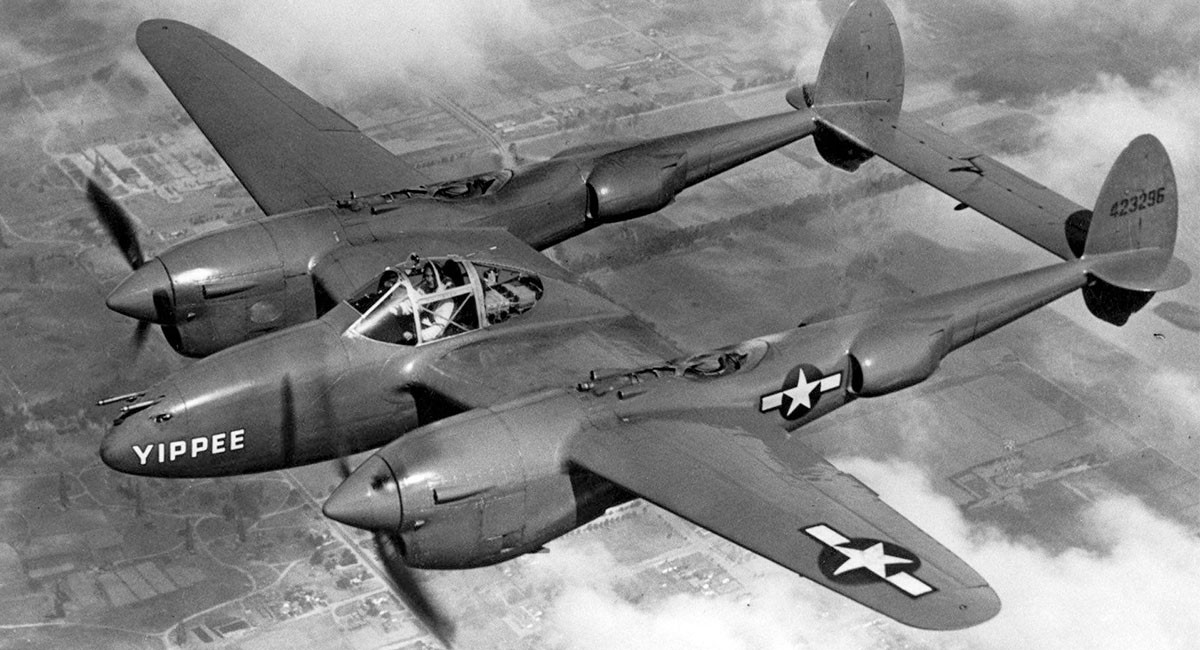
Lockheed P-38 Lightning
Role: FIGHTER / FIGHTER-BOMBER | Period: WORLD WAR 2 | Nation: USA
Category: Long-range fighter, Night fighter, Fighter-bomber, Reconnaissance aircraft
Crew: 1
Engine: Two reciprocating (piston) engines
Manufacturer: Lockheed Corporation
Number built: More than 10,000
First flight: 27 January 1939
Introduction: July 1941
Retired: 1949 (United States Air Force) / 1965 (Honduran Air Force)
The Lockheed P-38 Lightning was an American heavy fighter aircraft that was deployed in World War II. The P-38 has an unusual design, the fuselage consists of two engine nacelles, each topped with a rudder and connected by an elevator. The engines had a three-bladed metal propeller and between them was a nacelle with a single-seat cockpit, forward landing gear leg, radio equipment and integrated armament. It was the only American fighter aircraft to be produced on a large scale throughout the entire period of American involvement in World War II.
The early production version of the P-38E had a maximum take-off weight of 15,782 lb (7,159 kg), a maximum speed of 395 mph (636 km/h), a service ceiling of 38,999 ft (11,887 m) and a combat range of 400 mi (644 km). It carried no external armament.
The last production version of the P-38L had a maximum take-off weight of 21,600 lb (9,798 kg), an ammunition load of approximately 4,000 lb (1,840 kg), a maximum speed of 414 mph (666 km/h), a rate of climb of 4,750 ft/min (24.1 m/s), a service ceiling of 42,650 ft (13,000 m), and a combat range of 1,305 mi (2,100 km).
The P-38 Lightning was ruggedly built, fast, stable, and had an excellent rate of climb not achieved by any of its competing fighter aircraft. Piloting it, however, was not easy and required quality training. He also received conflicting reactions from his opponents, with German pilots nicknaming him the “fork-tailed devil” as well as the “sitting duck”.
In the end, however, the P-38 was flown by the most successful American pilots of World War II, such as Richard Ira Bong (40 confirmed kills) and Thomas McGuire (38 confirmed kills), who fought mostly in the Southwest Pacific. The famous French aviator and author Antoine de Saint-Exupéry also flew the P-38. The Lockheed P-38 Lightning also made history as the aircraft used to kill Admiral Yamamoto during Operation Vengeance.
Main variants of P-38 Lighting
- XP-38 – Prototype
- P-38 – First production version
- P-38D – Production version
- P-38E – Production version
- RP-322 – USAAF trainers
- P-38F – First fully combat-capable P-38 fighter
- P-38G – Production version
- P-38H – Production version
- P-38J – Production version
- P-38L – Production version
- P-38M – Night fighter converted from P-38L
- F-4 – Reconnaissance aircraft based on P-38E
- F-4A – Reconnaissance aircraft based on P-38F
- F-5A – Reconnaissance aircraft based on P-38G
- F-5B – Reconnaissance aircraft based on P-38J
- F-5C – Reconnaissance aircraft converted from P-38J
- F-5E – Reconnaissance aircraft converted from P-38J/L
- F-5F – Reconnaissance aircraft converted from P-38L
- F-5G – Reconnaissance aircraft converted from P-38L
XP-38, YP-38, P-38, P-38D Lightning (1939-1941)
The XP-38 prototype first flew on 27 January 1939, but was destroyed in a crash on 11 February. The aircraft set a speed record, flying from California to New York in seven hours and two minutes (two refueling stops were not included in the final time). Subsequently, a small preproduction group (13 units) of YP-38 test aircraft were ordered, and the first flight of this aircraft took place on 17 September 1940. The YP-38s were substantially redesigned, reducing weight and changing the engine mountings. The stability of the aircraft was improved by reversing the propeller rotation, with the blades turning outwards (away from the cockpit). Armament consisted of two .50 in (12.7 mm) and two .30 in (7.62 mm) machine guns.
The initial production run of 30 was the P-38 Lightning. It was delivered to the USAAF in mid-1941. Armoured glass in the cockpit and fluorescent instrument lighting were added. Armament was changed to four .50 in (12.7 mm) and one 37 mm (1.46 in) cannon. Based on reports from wartime Europe, the following series, numbering 36 and designated P-38D, was further improved. The aircraft received self-sealing fuel tanks (a type of fuel tank that prevents fuel leakage and ignition after damage) and armor protection was further strengthened.
P-38E Lightning, RP-322 (1941-1942)
The P-38E Lightning is the first production version ready for combat deployment. The first aircraft was completed in October 1941. Hydraulics and radio equipment were modified, and the integrated armament was changed to four .50 in (12.7 mm) machine guns and one .79 in ( 20 mm) cannon. This armament was not changed in subsequent versions. 210 were produced.
With the P-38E variant, the first Lightning victory over Japanese aircraft occurred when two pilots from the 343rd Fighter Group shot down a pair of Kawanishi H6K “Mavis” flying boats during a patrol flight. The incident occurred on 9 August 1942 in the Aleutian Islands area (the islands are part of the territory of Alaska).
This version was based on the reconnaissance variant of the F-4 Lightning, which had four cameras instead of integrated weapons. The F-4 was the first Lightning ever deployed in World War II, and was used in action with the 8th Photographic Squadron in Australia in April 1942. The P-38E was originally intended to be delivered to the RAF, but the contract was eventually abandoned and some of the aircraft prepared for the UK were converted to the RP-322 trainer version, numbering 147. The RP-322s were used for advanced flight training and later some were used for testing purposes.
P-38F Lightning / F-4A Lightning (1942)
The P-38F Lightning was heavier, had more powerful engines, but the maneuverability of the aircraft was still not ideal and its piloting was more challenging. The P-38F could now carry up to 2,000 pounds (910 kg) of bombs. The aircraft was deployed in the Mediterranean and Pacific theaters. 527 were built. In August 1942, the first American victory over a Luftwaffe aircraft was fought on this type, when a German Focke-Wulf Fw-200 Condor was shot down. Twenty F-4A Lightning reconnaissance aircraft were also based on this variant.
P-38G Lightning / F-5A Lightning (1942 – 1943)
The P-38F Lightning had an improved radio station, new Allison engines with up to 1,000 kW each and more efficient radiators. This variant participated in the operation in which the aircraft carrying Japanese Admiral Isoroku Yamamoto was shot down. Some P-38Gs had a modified nose that housed cameras instead of guns and were used for aerial reconnaissance. A total of about 180 machines were built in this variant, they were designated F-5A Lightning.
P-38H Lightning (since 1943)
The P-38H Lightning had more powerful Allison engines with up to 1,177 kW each, an improved 20 mm cannon, and received automatic oil radiator flaps. The armament load capacity on external hangers was increased to 3,200 lb (1,500 kg). The P-38H served primarily as a long-range escort for the B-17 Flying Fortress heavy bombers and B-24 Liberators belonging to the Eighth Air Force, which conducted raids over Europe. In total, there were 601 units of the P-38H variant.
P-38J Lightning / P-38J Droop Snoot / F-5B, F-5C Lightning (from August 1943)
The P-38J Lightning had the same engines as the previous version, but had redesigned air inlets for radiators under the engine and on the fuselage sides, increasing overall performance. The P-38J could also carry the new M8 unguided 4.5-inch (114 mm) caliber rockets. Hydraulically boosted ailerons were added from the later P-38J-25-LO version, greatly improving the handling of the aircraft. A total of 2,970 P-38Js were produced, of which 123 were converted to the F-5B Lightning reconnaissance variant. The P-38J was also used as the basis for 200 units of the specialized F-5C Lightning reconnaissance variant.
From the P-38J, a specialized variant was newly created to guide formations of medium and heavy bombers or other P-38s on target. This variant was given the designation Droop Snoot and was equipped with a bomb sight and radar system. The P-38 led the bombing formation up to the target over which it first dropped bombs and the rest of the formation followed.
P-38L Lightning / P-38L Pathfinder / P-38M Night Lightning / F-5E, F-5F, F-5G Lightning (1944-1945)
The P-38L Lightning entered service in June 1944. It had more powerful Allison engines, each rated at 1,200 kW, and new hinges for 10 127mm HVAR missiles were built under the outer wing sections. The P-38L entered the European battlefield with the invasion of France as part of Operation D-Day. It operated on the European and Pacific fronts until the end of the war and was the most numerous P-38L variant, with 3,923 produced.
The P-38L also operated in a variant for guiding bomber formations to their targets, and like its predecessor, the P-38J Droop Snoot, carried specialized targeting and radar equipment, but in a different configuration, its designation was the P-38L Pathfinder.
A total of 75 P-38L aircraft were modified for night fighter operations and given the designation P-38M Night Lightning. The Night Lightning had a radar module mounted under the nose and a second, elevated cockpit behind the cockpit for the radar operator. The P-38M Night Lightning’s camouflage consisted of black paint on all surfaces.
Reconnaissance variants were also created, with 705 machines converted from the P-38J and P-38L variants and designated as F-5E Lightning. Other reconnaissance versions were the F-5F Lightning and F-5G Lightning, which had different camera equipment. The F-5F and F-5G were also in Free French Air Force/French Air Force service, and after the war the F-5E variant was also received by the Italian Air Force.
Operational service of P-38 Lighting
The P-38 Lightning was primarily used as a long-range heavy fighter aircraft, but it also served in a variety of other roles, including attacks on ground targets, torpedo attacks against ships, reconnaissance flights, ambulance deployments, and guiding bomber strike teams to targets (these specialized aircraft were designated the P-38 Pathfinder and P-38 Droop Snoot. The aircraft was also modified for night fighter flights, and these modifications resulted in a separate specialized variant for these missions designated the P-38M Night Lightning.
- World War 2 (1939 – 1945) – Mediterranean and Middle East War Theater
- World War 2 (1939 – 1945) – European Theater – Western Front
- World War 2 (1939 – 1945) – Pacific Theater – South Pacific Area
- World War 2 (1939 – 1945) – Pacific Theater – South West Pacific Area
- World War 2 (1939 – 1945) – Pacific Theater – China Burma India Theater
North Africa and Italy
In 1942, the USAAF began moving its fighter groups to the UK across the Atlantic and Iceland. On 14 August 1942, pilots from the 27th Fighter Squadron shot down a German Focke-Wulf Fw 200 Condor bomber over the Atlantic, the first shoot-down of a German aircraft by USAAF aircraft.
Subsequent deployments of the Lightnings in the UK did not yield much operational success and the aircraft were moved to Algeria, North Africa (where P-40 Warhawk aircraft were already operating) to take part in Operation Torch. The first operational deployment took place on November 11, 1942, and the first kill on that battlefield occurred on November 22, when Lt. Mark Shipman of the 14th Squadron shot down an Italian aircraft. On 28 November 1942, however, the Luftwaffe’s first success against the P-38s occurred in contrast, when Messerschmitt Bf 109 pilots from Jagdgeschwader 53 shot down 7 of those aircraft, with no losses of their own.
The primary role of the P-38 in North Africa was to escort bombers, but later they were also used to attack ground targets. The P-38’s overall results on this battlefield were mixed. The aircraft achieved some success, but also suffered significant losses, also due to pilot inexperience and tactical limitations. These losses led to a change in tactics in protecting the bomber formation. The original intent was to stay close to the bombers at all times, which proved to be an inappropriate tactical element, and from February 1943 onward, P-38 pilots were given a free hand in combat in pursuit of enemy fighters.
Western Europe
The Lightnings’ primary mission on this battlefield was to protect heavy bomber formations, in raids over Germany and other areas where they took full advantage of their long range. The P-38H fighters were transferred to the Eighth Air Army in September 1943 to perform this task.
During the Normandy invasion and the Allied advance into Germany, they also performed the role of fighter-bomber and attacked ground targets. From September 1944, most of the Lightnings in the Eighth Air Army were replaced by P-51 Mustangs, with the remaining aircraft primarily performing reconnaissance missions (F-5 version). The total number of sorties on this battlefield reached 130,000.
Pacific Theater
The P-38 Lightning saw its most extensive deployment in this theater, where it took full advantage of its two reliable engines and exceptional range. It was used in a variety of roles, particularly as a high-altitude escort for bombers. The P-38 achieved more kills of Japanese aircraft than any other USAAF fighter aircraft.
The Lightning shot down more than 1,800 Japanese aircraft and more than 100 of its pilots became Aces (after shooting down five or more enemy aircraft). In aerial combat, it relied primarily on its speed, firepower and, most importantly, its excellent climb rate. On April 18, 1943, P-38G Lightning aircraft took part in one of the most important operations in the Pacific – Operation Vengeance, during which Admiral Isoroku Yamamoto (the architect of the attack on Pearl Harbor and Japanese naval strategy in the Pacific) was killed.
Post-war operations
P-38s served in the US Air Force until 1949. In the postwar period, the Lightning was the aircraft of choice for air races at Reno and Cleveland (1946 to 1949). About 100 aircraft were delivered to the Italian Air Force between 1949 and 1952. The P-38 was also delivered to Honduras (12 units), China (15 units), and a reconnaissance variant to the Dominican Republic (8 units).
As late as 1957, the P-38 Lightning took part in combat operations. During a border dispute over the department of Gracias a Dios between Honduras and Nicaragua, five Honduran P-38s strafed a village occupied by Nicaraguan forces. The P-38 served in the Honduran Air Force until 1965.
